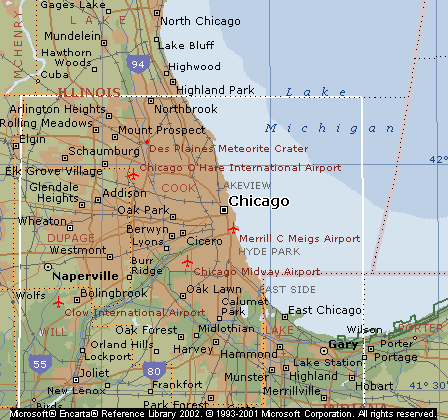

Home - Chicago - Banking - Buying a House - Churches - Family Programs - Govt. Offices - Insurance - Hospitals - Jobs - Mail -
Moving Tips - Radio - Renting - School - Shopping - TV - Transportation - Utilities - Links
Chicago
A short history and information on Chicago: Chicago,
city and seat of Cook County, located in northeastern Illinois, on the
southwestern shore of Lake Michigan, at the mouth of the Chicago River. Chicago
is the third largest city in the United States and one of the country’s leading
industrial, commercial, transportation, and financial centers.
Downtown Chicago Flowing westward from Lake Michigan, the Chicago River winds
through downtown Chicago. Skyscrapers rise along its banks.
Chicago covers a land area of 588.2 sq km (227.1 sq mi) and extends 47 km (29
mi) along Lake Michigan. It occupies flatland traversed by two short rivers: the
Chicago River, which flows west from the lake through the downtown area, where
it forks into a North Branch and a South Branch; and the Calumet River, in the
south, which connects with the small Lake Calumet. Both rivers are linked by
canals with the Illinois and Mississippi rivers, establishing Chicago as the
connecting point in the waterway between the Mississippi Valley and the Great
Lakes-St. Lawrence Seaway. The city’s rapid growth was due in large part to its
location, with ready access to markets and raw materials.
After a population decline since the 1950s, the population of
Chicago increased from 2,783,726 in 1990 to 2,896,016 in 2000. According to the
2000 census, whites constitute 42 percent of the city’s population; blacks, 36.8
percent; Asians, 4.3 percent; Native Americans, 0.4 percent; and Native
Hawaiians and other Pacific Islanders, 0.1 percent. People of mixed heritage or
not reporting ethnicity were 16.5 percent of inhabitants. Hispanics, who may be
of any race, represent 26 percent of the city’s population.
Chicago is the center of a large metropolitan area spreading across three
states, from Kenosha, Wisconsin, in the north to Gary, Indiana, in the
southeast. The population of the consolidated metropolitan statistical area
increased from 8,115,000 in 1980 to 8,240,000 in 1990. It reached 9,157,500 in
2000. The percentage of minorities is lower in the metropolitan area than in the
city. Blacks account for only about one in five in the metropolitan region as a
whole, and Hispanics represent approximately one in nine residents. While the
proportion of Hispanics is growing in the metropolitan area, black presence has
remained mostly unchanged.
Almost every ethnic group found in the United States is represented in Chicago.
In 1990 more people claimed German ancestry in Chicago than any other ancestry,
followed by Polish and Irish. Almost 45 percent of the more than 450,000
foreign-born people now living in Chicago entered the United States between 1980
and 1990. Spanish and Polish are the two most common languages spoken at home
other than English.

© Copyright 2004. All rights reserved.
Contact Webmaster:
Boris L.